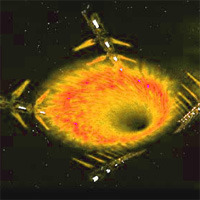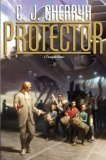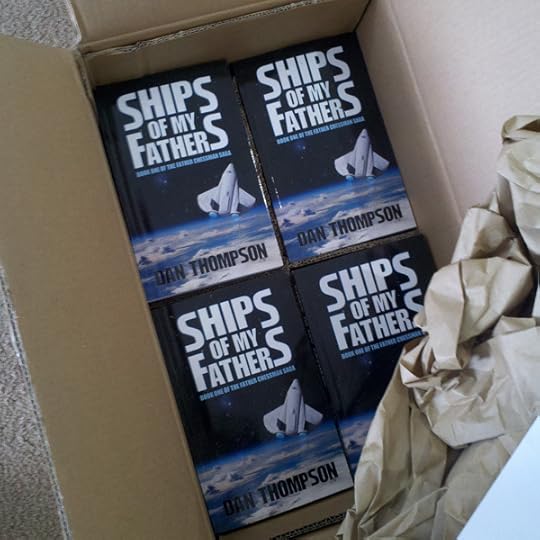Dan Thompson's Blog, page 8
June 7, 2013
Review: Captain’s Fury, by Jim Butcher

 This is the fourth book in Butcher’s epic fantasy Fury series. Here we follow Tavi and others as they repel the Canim invasion and battle against a rebellious High Lord. There are a fair number of dark deeds done because the alternative was worse, but in the end, good prevails, of a sort.
This is the fourth book in Butcher’s epic fantasy Fury series. Here we follow Tavi and others as they repel the Canim invasion and battle against a rebellious High Lord. There are a fair number of dark deeds done because the alternative was worse, but in the end, good prevails, of a sort.
As for Tavi’s personal journey, he… hmm, this gets hard without getting into spoiler territory. He picks up some new skills and learns some more about his personal history. He continues to kick butt in various ways and inspires a surprising collection of supporters to kick butt for him. And as always, he shows that in a world of dark sorcery and elemental furies, the best weapon is still calm intelligence.
I did enjoy this one quite a bit, though I have to say I didn’t enjoy it quite as much as the previous book Cursor’s Fury. The writing was superb, of course, and the characters were compelling. I suspect that this time, however, the plot was not as gripping as the previous one. There was simply too much time spent getting from point A to point B, sometimes plotwise and other times geographically. Thus, when the various plots reached their climax, I felt they were about 100 pages overdue.
Not that this is going to stop me from going after the last two. I’m definitely seeing this one through to the end.
May 27, 2013
FTL Flavors: Wormholes
 This is the fourth in my series on various flavors of Faster Than Light (FTL) travel, and today I’m dropping into wormholes. The basic idea of a wormhole is that it’s a shortcut between two points. Usually they are fixed points, but there’s some variation on that. Sometimes they are done as predefined shortcuts through some alternate parallel space, and other times they are special tunnels through our own space.
This is the fourth in my series on various flavors of Faster Than Light (FTL) travel, and today I’m dropping into wormholes. The basic idea of a wormhole is that it’s a shortcut between two points. Usually they are fixed points, but there’s some variation on that. Sometimes they are done as predefined shortcuts through some alternate parallel space, and other times they are special tunnels through our own space.
In most cases, they are fairly permanent and independent of the ships traversing them. Thus, ships that have only sublight capabilities are now about to cross vast interstellar distances just by popping through these wormholes, just like a pedestrian can cross town quickly by taking the subway.
FTL-to-FTL interactions: These are almost nonexistent. The only interactions you might have are with other ships (or beings) that are in the same wormhole with you. Plus, wormhole trips are usually presented as being fairly short, so the opportunities for interaction would be fleeting.
FTL-to-sublight interactions: There are none. At least, that’s how I typically see it done. The wormhole is completely cut off from the rest of the universe. At best, there might be some communication with stations near either end of the wormhole.
Relativistic effects: Typically, there are none. Sometimes the transits are essentially instant, like walking through a doorway. Other times, they last seconds to hours, but it’s generally presented as time flowing tick by tick along with a stationary timeframe.
However, I know of one wormhole setup where the wormhole is a tubular region of space where time flows thousands of times faster than normal, thus making the speed of light in that region thousands of times faster. Ships passing through this make up for the time-scale by travelling at relativistic speeds, thus slowing their internal time by a similar factor to the external speed increase. Thus, they make a multi-year journey in a few minutes according to their own clocks and quite possibly a few minutes according to our clocks as well. In that setup, however, there is no guarantee of an absolute matchup between the ship clocks and the stationary clocks, so there would be some variation from one wormhole to another, and sometimes even from one trip to another on the same wormhole.
In-FTL Navigation: Nope, sorry. You don’t get to steer the train. You can’t even pull the emergency brake. And no hopping out the back either. You stay on it until it dumps you out the other end. Do not pass Rigel. Do not collect two hundred quatloos. Your best bet is to hope that there are other wormholes near the end of this one so that you can exercise at least a little choice.
Speed Differential: In all the wormhole systems I’ve seen, the ships within the wormhole all travelled through it at the same speed. Or if there was any speed variation, it was not under the control of the ships themselves. They were merely being swept along by currents of different speed. Of course, there’s no guarantee that all wormholes move you along at the same speed.
Malfunctions: All the breakdowns I’ve seen with wormholes have been with the wormholes themselves. Either they collapsed or became untethered at one end. Typically, the worst that happens to you is that you’re stuck at the wrong end of a wormhole. Then again, I’d hate to be inside one when it collapsed.
Special traits: Wormholes have several interesting traits in the story-telling sense. The first is that they are often pre-existing objects outside the control of the characters using them. Maybe they’re naturally occurring phenomena, or maybe they were built by “the ancients”. Or maybe, like the subways, they were built by the government, and we peons have to live with them as they are. They key here is that it’s no longer a space travel system where we get to pick out our destination and sail on through the night. Instead, there are a handful of destinations to pick from, and if that’s not where we want to go, that’s just too bad.
The second interesting thing about wormholes is what they do to the Euclidean topology of space. I’m not referring to some freaky space warping around the wormhole entrance. Rather, I mean that Rigel is now 500 million kilometers away rather than 900 light years, because there’s a wormhole to take us there. Meanwhile, our next door neighbor Proxima is still 4.24 light years away because it has no wormhole. Yet another nearby star Sirius is now only 2.1 billion kilometers away (rather than 8.6 light years) because we can get to it via a series of wormholes, i.e. first Rigel, then to Polaris, Antares, Deneb, and finally Sirius. (Don’t get lost at Deneb – it’s a bad neighborhood.)
And finally, if the wormholes are not strictly ignorant carriers of traffic, but instead, intelligent agents of control, then those first two factors can make for some very interesting situations. Imagine being able to control all commerce, traffic, even information flow between these distant stellar islands, simply by deciding which ships will complete their journey, which worlds to cut off, or which radio transmissions to shunt aside. Now start thinking about it from the point of view of we peons not realizing that the wormholes are under intelligent control, and let your space-opera paranoia turn all the way up to Eleven.
 But one last bit on wormholes. Like the warp drive, these might be possible if not actually feasible. What we call a wormhole is remarkably similar to a prediction of General Relativity, known more properly as a Einstein-Rosen Bridge. However, since our best theoretical examples of such wormholes are tied up with black holes, this still has a long way to go to before we can turn it into the green-line express from Sol to Rigel.
But one last bit on wormholes. Like the warp drive, these might be possible if not actually feasible. What we call a wormhole is remarkably similar to a prediction of General Relativity, known more properly as a Einstein-Rosen Bridge. However, since our best theoretical examples of such wormholes are tied up with black holes, this still has a long way to go to before we can turn it into the green-line express from Sol to Rigel.
Tune in next week when we go Jumping.
May 20, 2013
FTL Flavors: Hyperspace
 This is the third in my series on different flavors of Faster Than Light (FTL) travel, and today I’m taking a look at hyperspace. The general idea here is that there is a separate space, parallel to our own, that allows for shorter travel between two points. It’s no longer four light years to Proxima. Instead, you transition over to hyperspace, travel a hundred thousand kilometers, and drop back into normal space at Proxima.
This is the third in my series on different flavors of Faster Than Light (FTL) travel, and today I’m taking a look at hyperspace. The general idea here is that there is a separate space, parallel to our own, that allows for shorter travel between two points. It’s no longer four light years to Proxima. Instead, you transition over to hyperspace, travel a hundred thousand kilometers, and drop back into normal space at Proxima.
Generally, hyperspace is considered to be as Euclidean as normal space (which is not always truly Euclidean) and is scaled linearly with normal space. That’s the $5 way of saying that if you go twice as far in hypespace, you’ll go twice as far in normal space and in the direction you would have expected.
 The only tricky thing about hyperspace is getting between normal space and hyperspace. In some stories, your ship can contain the necessary equipment to open a transition point. In other tales, it requires a gate in normal space to open that transition point. But once you’re over in hyperspace, it’s just a matter of throttling up or sailing away.
The only tricky thing about hyperspace is getting between normal space and hyperspace. In some stories, your ship can contain the necessary equipment to open a transition point. In other tales, it requires a gate in normal space to open that transition point. But once you’re over in hyperspace, it’s just a matter of throttling up or sailing away.
Let’s see how the details break out.
FTL-to-FTL interactions: This varies. In some stories, hyperspace is a chaotic or void space that is completely incomprehensible, so you cannot interact with other ships even if they were supposed to be flying formation with you. In other tales, hyperspace is pretty much just like normal space but with better graphics. In those cases, you can fly around, talk to other ships, and even shoot at them. Of course, there’s room to play around between those two extremes such as limiting communication range due to “hyperspace flux” or the likes.
FTL-to-sublight interactions: Usually there are no interactions here. You are in a truly separate space. At best there is a level of communication, but that is typically done via fixed points like gates. However, I have seen a couple of odd exceptions to this rule, typically where something unusual in normal space (such as a supernova or black hole) will cause a disturbance in hyperspace.
Relativistic effects: Generally there are none. The ships aren’t typically travelling very fast in hyperspace. It’s just that the distance there is shorter. Either that, or there is simply no special relativity in hyperspace. However, I have seen an odd time variation in some of C.J. Cherryh’s stories where mental processes continue on at a normal pace while other biological processes slow down. This allows frequent travelers to have a mental age of 40 while still appearing to be only 30.
In-FTL Navigation: This can vary, but there is almost always some. At the very least, ships travelling through hyperspace have the option of dropping back to normal space early, short of their destination. Course changes might require such a transition back to normal space, but there is that option. However, in most cases, hyperspace seems to allow as much navigational flexibility as the warp drive, complete with screeching turns and barrel rolls. Still, one limitation on this is the fixed points of gates. If you can only transition via the gates, then all the zigs and zags of your pilot won’t change the fact that you really only have a handful of destinations.
Speed Differential: Again, there typically is speed differential in hyperspace, typically achieved simply by travelling faster or slower within hyperspace. Sometimes, though, I have seen it done with multiple parallel spaces with different speed limits with them, e.g. hyperspace-A allows an effective 10-to-1 speed boost, while hyperspace-B gives 1000-to-1. However, I have seen a few cases (notably most of Jack McDevitt’s Omega Cloud series) where all ships travel through hyperspace at the same rate, since that is believed to be a fundamental property of hyperspace.
Malfunctions: These can suck. The most common malfunction is with your ability to transition to and from hyperspace. If you end up stuck in normal space, you’re just like the folks with the busted warp-drive, sticking your thumbs out in hopes of rescue. Except, of course, if you’re out in the middle of interstellar space, there won’t be any warp-drive ships careening past to see you. Instead, they’ll all be passing by unseen in hyperspace. Even worse is when you get stuck in hyperspace. Unless you can get to a gate to transition back, you’re left to the mercy of whatever monsters the author has left lurking in the dark corners of this alternate reality. Most often, those ships will simply disappear like the sailing ships of old, leaving only grieving widows and frustrated insurance adjusters.
Special traits: This is a nice dodge around relativity’s limits that doesn’t require much hand-waving with dubious physics. About the only big decision to make is whether or not ships can generate their own transition points or if some or all of them require a system of gates.
Tune in next week for a look at wormholes.
May 17, 2013
Review: Protector, by C.J. Cherryh

 This is the fourteenth – yes, fourteenth! – book in the Foreigner series, following the interpreter-ambassador Bren Cameron on his adventures through the Atevi’s world of deadly intrigue.
This is the fourteenth – yes, fourteenth! – book in the Foreigner series, following the interpreter-ambassador Bren Cameron on his adventures through the Atevi’s world of deadly intrigue.
I confess that I’ve been waiting for Cherryh to pick up again on a plot thread left hanging in book 6, and it’s not like she’s forgotten about it. Indeed, the looming return of that plot thread is on everyone’s mind, but we did not get it in this book. I found that very disappointing in the previous book, but I did not mind it so much this time because the rest of the story was so engaging.
It would seem that young Cajeiri (son of the Atevi ruler) is finally going to have his felicitous ninth birthday, and to celebrate it, three of his human friends will be coming down from the space station to join him. Certainly, things have been tense, but it looks like, for once, he will have a nice smooth birthday.
Of course, not everyone wants it to come off that smoothly. He is a ripe target for assassination, as is his uncle, his great-grandmother, and Bren himself. Will the outlawed shadow guild actually make an attempt at all of them? Or are they unknowingly biting off more than they can chew?
It’s good old Atevi politics and assassination plots at their finest. If you’re an old Atevi hand, fluent in Ragi, and clear on your man’chi, go ahead and grab this one. It’s a worthy installment. I won’t say that it ends on a cliffhanger, but I’ve got a pretty good idea what the next book is about. Plus, Cherryh has hinted that the long-delayed plot thread from book 6 might be making a return soon. Can I hope?
If all of this is new to you, I direct you back to the first book, Foreigner. I admit it’s a bit of a slow start, but it sets the world off in the right direction. Think of the TV show Downton Abbey but with aliens and deadly politics.
May 15, 2013
Fixed Format
I caught a couple of formatting errors in the print edition of Ships of My Fathers. Well, ok, I caught five of them.  Nothing too major, just a funky justification/indent bug in Word.
Nothing too major, just a funky justification/indent bug in Word.
Anyway, they are now fixed, and the new version should be live in a day or two.
May 13, 2013
FTL Flavors: Warp Drive
 This is the second in my series on the different flavors of Faster Than Light (FTL) travel, and today I’ll be looking at the warp drive. The ideas for warp drive predate Star Trek, and they weren’t always called by that name, but Captain Kirk and the Enterprise are the iconic example of the warp drive. With a few words of technobabble, the universal speed limit is suddenly gone.
This is the second in my series on the different flavors of Faster Than Light (FTL) travel, and today I’ll be looking at the warp drive. The ideas for warp drive predate Star Trek, and they weren’t always called by that name, but Captain Kirk and the Enterprise are the iconic example of the warp drive. With a few words of technobabble, the universal speed limit is suddenly gone.
Yes, they paid lip service with the distinction between impulse drives and the warp drive, and over the years, they’ve filled our heads with all the technical details of subspace fields, warp bubbles, and such, but the basic result is that we are no longer bound by the upper limit of lightspeed. Let’s look at how some of the details shake out.
FTL-to-FTL interactions: Two ships travelling at warp speed can interact. That seems pretty universal. They can travel together, see each other coming, even take pot shots as they fly past. Sometimes there are a few restrictions, but they’re usually more of the nature of “that’s never been attempted at this speed!” In other words, they’re dramatic challenges for the engineer, not fundamental limitations on the physics.
FTL-to-sublight interactions: Yes, you can see the planet coming, and it can see you. You can steer around it and come back in for a strafing run. Stories with warp drive usually ignore the fact that you can’t literally see something coming at you faster than light with vague talk of “long-range sensors”.
Relativistic effects: Warp drives almost never deal with relativity. I think a lot of this is that once having dispensed with Einstein’s limits, they would rather not bring up real physics again. However, I have seen one or two instances of mild relativistic effects with warp drives. Kube-McDowell’s Trigon Disunity trilogy had a drive that ultimately moved the ship faster than light via some tricks of warped space, but the occupants were also travelling at relativistic speeds within that warped space. Thus, they experienced less than half the elapsed time as their Earthbound friends.
In-FTL Navigation: Warp-drive ships generally have no problem turning to starboard at faster than light speeds. Since we’re now pretending there’s nothing special about the speed of light and imagining ourselves in space-going navy vessels, there is no reason to suspect otherwise.
Speed Differential: Yes, the Joneses have a faster warp drive than you do. After all, if there is no longer an upper limit on speed, someone is always going to be at least little faster than you. Of course, since speed variation is possible, this also means you don’t have to be traveling at your maximum speed all the time. You can save warp 9 for the really dramatic moments.
Malfunctions: Whether it’s something as minor as a crack in the dilithium crystals or an ejected warp core, you’re not necessarily dead when things go wrong with your warp drive. Most of the time, you’re simply restricted to sublight travel again as Einstein takes a brief rest from spinning in his grave. Of course, many faults can be repaired, and you can get moving again. Failing that, you just have to stick out your warp thumb and wait for rescue.
Special traits: For storytelling, this is probably the easiest and to write and the simplest to grasp. It essentially ignores relativity and removes the problem of interstellar distances from the story. Rigel-4 is no longer hundreds of light-years away. It’s merely on the other side of the pond, so climb aboard the newest ship from the White Star Lines and have a safe… er… at least a short voyage.
 But ironically, this flagrant slap in the face to physics is starting to look like it just might, maybe, theoretically be almost possible. In 1994, Miguel Alcubierre proposed a way of changing the shape of space around us, shrinking it in the direction we wanted to travel and expanding it in the direction behind us. It requires some pretty crazy technology, the science for which is still pure speculation, but after about twenty years, it has a few people seriously considering it as a matter for research. How seriously? Apparently NASA is spending some of its precious half-pennies on it. It might not be much more than a publicity stunt, but there’s always that outside chance that it might be something huge.
But ironically, this flagrant slap in the face to physics is starting to look like it just might, maybe, theoretically be almost possible. In 1994, Miguel Alcubierre proposed a way of changing the shape of space around us, shrinking it in the direction we wanted to travel and expanding it in the direction behind us. It requires some pretty crazy technology, the science for which is still pure speculation, but after about twenty years, it has a few people seriously considering it as a matter for research. How seriously? Apparently NASA is spending some of its precious half-pennies on it. It might not be much more than a publicity stunt, but there’s always that outside chance that it might be something huge.
So, tune in next week when we take a tour of hyperspace…
May 10, 2013
Review: Fated, by Benedict Jacka

 This is the first book in the Alex Verus series, of which there are currently three – and a fourth one coming out later in 2013. A friend from Australia recommended them to me, saying “If you liked the Dresden Files, you’ll like these.” That set a high bar, but I was not disappointed.
This is the first book in the Alex Verus series, of which there are currently three – and a fourth one coming out later in 2013. A friend from Australia recommended them to me, saying “If you liked the Dresden Files, you’ll like these.” That set a high bar, but I was not disappointed.
In many ways, it’s a Dresden-like world with wizards and other magical creatures hiding beneath the surface. He even makes a cute reference to Dresden with a remark of “supposedly there’s a wizard in Chicago who advertises in the phone book.” There’s even some wizard organizations, of both good and evil varieties. And our hero is one of these wizards, somewhat caught between the two camps, much like Dresden.
But the similarities end there.
Alex Verus is no fire-wielding combat wizard. In fact, he’s quite the opposite. In face to face combat, he can’t do much more than throw a punch or try to trip you. You see, he’s a diviner who can see the future. But of course, seeing the future means you can change it, so what he really sees is the massively bifurcating tree of possible futures.
Do I turn right or left here? Do I say hello or run like hell? Do I accept this offer, or do I find out that it truly is an offer I cannot refuse? He can explore all those options and try to make the decisions that keep his body and soul joined. But he can only see so far, and he can’t see past someone else’s independent decisions. So, like most good diviners, he puts most of his efforts towards laying low and staying out of trouble.
But then trouble comes looking for him. The various powers-that-be want help cracking open a mysterious artifact, and to do that, they need a diviner. It’s a magical safe-box of sorts, and who else would ask to see the future of all those magical combination locks? Alex is not exactly at the top of the list for diviners, but the best of them have all coincidentally realized that now is a good time to be far, far away from this artifact and those who would open it. Alex isn’t quite that smart, or that lucky.
So he gets drawn back into a world he had done his best to leave behind, hoping he’s smart enough to find his way back out again when it’s all over.
I liked it. A lot. As much as I enjoy Harry Dresden blundering in with his blasting rod and .44 Magnum , he solves more of his day-to-day problems through brute force rather than cunning guile. Alex Verus doesn’t have the option of firepower.
He has to be smart. Or dead. He tries to be smart.
May 8, 2013
A Box of Books
For various promotional purposes (as well as gifting copies to the folks who helped me along the way), I ordered a box of my latest book. It arrived today!
(Doing my little happy dance!)
May 6, 2013
FTL Flavors
 I don’t know which came first, the fictional accomplishment of travelling faster than light or Einstein’s prohibition against it, but one thing is certain, fictional FTL travel is here to stay. The genre of space opera almost requires it, and it has become a convenient cheat for telling stories over vast distances while still keeping them within our grasp.
I don’t know which came first, the fictional accomplishment of travelling faster than light or Einstein’s prohibition against it, but one thing is certain, fictional FTL travel is here to stay. The genre of space opera almost requires it, and it has become a convenient cheat for telling stories over vast distances while still keeping them within our grasp.
This is the first of a six part series on the various flavors of FTL travel. Specifically, I’ll be breaking down the various forms of FTL travel and looking at how they work. I won’t be digging into the technobabble of fictional engineering manuals. Instead, I’ll be taking a look at how they work it story terms, i.e. what they allow, what problems they present, and so on.
Specifically, I’ll be examining each of them under these criteria:
Does it allow for FTL-to-FTL interactions? When you’re on your way from Earth to Rigel-4, can you run into another ship? Can you talk with them? Can you get into a fight with them? Or does this particular brand of FTL prevent those FTL ships from passing in the night?
Does it allow for FTL-to-sublight interactions? This is similar to but distinct from the first question. If you pass some planet along the way, can you see it? Can you make an FTL strafing run against some unsuspecting target? Or can they somehow see you coming?
Do you still have any relativistic effects? We might be mooning Einstein as we blow past at warp 5, but it might be possible to have some strange time dilation effects in place. Maybe you still age a little slower? Or faster? Or is it random?
Does it allow for in-FTL navigation? Do you set your destination and then trust to luck, or are you keeping one hand on the wheel at all times? If you find out that you’ve made a wrong turn, can you fix it, or do you simply have to wait until you get to other side?
Is all FTL the same speed? Does this particular FTL allow for some ships to be faster than others? Can you chase someone and catch up? Can you outdistance your pursuer? Or are we all on the same train?
What goes wrong? No mode of travel is without the occasional flat tire or torn wing. When your FTL engine breaks, what is the fallout? Are you left in space sticking your thumb out, hoping for a ride, or did you disappear into an alternate dimension, never to be heard from again? Or do things simply go boom?
And finally, is there anything that makes this particularly special? What makes it distinct from all the other go-go-go gadgets in the spacelanes? Is it man-made, a natural phenomena, or a gift from the ancients?
So, I hope you’ll tune in over the coming few weeks as I pop the hood on various starships and take a look at the story mechanics inside.
May 3, 2013
Review: Starbound, by Joe Haldeman

 This is the sequel to Marsbound, which I reviewed earlier. In this one, our protagonist Carmen heads off on a relativistic sublight trip to a nearby star to meet with the aliens who were behind the machinations of Marsbound.
This is the sequel to Marsbound, which I reviewed earlier. In this one, our protagonist Carmen heads off on a relativistic sublight trip to a nearby star to meet with the aliens who were behind the machinations of Marsbound.
I was a little disappointed by this one, not so much for the story itself but for some of the mechanics of how it was told. The basic story is that of the journey, i.e. the preparations, the long trip itself, and what happens once we get to the destination. Those aspects were fairly interesting and held my interest, so on the basic point of telling a good story, I’ll give it good marks.
However, while Marsbound was told from the single point of view of Carmen, “the girl from Mars”, Starbound is told from three separate first-person points of view: two human and one Martian. I can see some justification for the choice, but it ended up confusing me frequently. I could get two or three pages into a chapter and not be sure who the current “I” was. It would have been nice if each chapter could have led off with some identification, even if it was something explicit like the character’s name in the chapter heading.
The second mechanical thing that soured the book for me was something of a cheat. Telling the story of a thirteen-year round-trip voyage is hard to do without boring the reader to tears. Yet Haldeman pulled it off for the first three-and-a-half years or so. Then… I don’t know, maybe he ran out of steam. Maybe he just didn’t want to have to do another nine years of it, so he pulled a rabbit out of his hat and made it go away somewhat magically. He went to some length explaining why we wouldn’t understand the real explanation, but it still felt like a cheat.
So, while I enjoyed the tale, I was disappointed by some of the execution. I’ll probably finish off the trilogy, but I’m no longer quite so excited about it as I was after Marsbound.




